 October 25, 2018 John E. Ross, KD8IDJ, Editor
| ||||||
Successful Ham Radio Contact between Students and Space Station Excites and Inspires "My best day as a teacher!" was educator Kathryn Craven's exuberant reaction following a successful October 22 ham radio contact between International Space Station (ISS) crew member Serena Auñón-Chancellor, KG5TMT, and youngsters at Ashford School in Ashford, Connecticut. ARRL Headquarters provided equipment for the Amateur Radio on the International Space Station (ARISS)-sponsored event, and several ARRL Headquarters staffers were among those assisting in setting up the station, working with teachers, students, and the media, shooting photos, and offering other support.
The entire student body of the kindergarten-through-eighth grade school in northeastern Connecticut sat in rapt attention during the event, as a dozen of their classmates spoke directly to Auñón-Chancellor, who was at the helm of NA1SS on the ISS. Using ARRL's equipment, members of the Eastern Connecticut Amateur Radio Association (ECARA) set up the Earth station (KZ1M), with technical and hands-on help from W1AW Station Manager Joe Carcia, NJ1Q, who also assisted in summoning NA1SS for the approximately 10-minute pass. One reporter asked Carcia what was being displayed on the large screen. "I explained that the program we were using -- SatPC32 -- allowed us to see where the ISS is located and controlled the rotators with respect to our location," he said. Some Ashford School students have been studying microgravity and are working on a research project that they hope will eventually be selected to be conducted on the ISS. Auñón-Chancellor, the Mission 56/57 flight surgeon, answered 16 student questions that ranged from "Do you wear sunscreen into space?" to "What is the hardest thing about having zero gravity?" and "How many flips can you do?" Others attending on behalf of ARRL were ARRL Lifelong Learning Manager Kris Bickell, K1BIC; Lifelong Learning and Knowledge Department Administrator Ally Riedel, KM3ALF; ARRL Communications Content Producer Michelle Patnode, W3MVP, and ARRL Communications Manager David Isgur, N1RSN.
"It was great!" Patnode said afterward. "The space station responded right away, and everyone instantly got so excited." Crews from four local television stations and print publication reporters joined an audience of more than 400. "We are so incredibly grateful to ARISS, ECARA, and ARRL for making this possible for the entire Ashford School community," a statement on the school's website said. "Our students were literally bursting with excitement at the end of the contact. Look out universe -- here comes the Mars generation!" Ham Aid Kits Positioned to Deploy as Typhoon Yutu Ravages Central Pacific Islands In a little more than one day, the cyclone that became Super Typhoon Yutu grew from tropical storm to a Category 5 monster. Yutu is said to be the strongest storm on record to hit the Northern Mariana Islands, home to about 55,000 people. The storm made landfall on Wednesday evening (October 24), destroying homes, wreaking severe wind and storm-surge damage and flooding, and knocking out water, power, and telecommunications on the islands. Utilities could remain down for an extended period.
ARRL Emergency Preparedness Manager Mike Corey, KI1U, said that four ARRL HF/VHF Ham Aid kits in Guam are available for use in the Commonwealth of the Northern Mariana Islands (CNMI), a US territory. Another seven kits are positioned in Hawaii. Corey said that radio amateurs in Guam and Hawaii are attempting to get in touch with hams who can assist on Saipan, part of the CNMI. Amateur Radio teams that had planned to operate in the CQ World Wide SSB Contest from Saipan this weekend have cancelled their trips. "There is a small group of radio amateurs on Saipan who do VHF work," Corey said. "We are in process of reaching out to them, as well as to radio amateurs who go to Saipan and Tinian for the CQ WW SSB event."
One PACTOR-4-equipped station is available on Guam, and Winlink (radio email) gateways exist in Hawaii. "There are no transportation arrangements available to ARRL at this time to move Ham Aid kits from Hawaii to Guam," Corey said. "We don't intend to move them unless we have operators in Guam/Saipan to use them." The Marianas Amateur Radio Club (AH2G) in Guam has posted photos and updates from Saipan on its website. Read more. Waterlogged VP6D Ducie Island DXpedition Reported to be "Progressing Well" Significant rainfall this week hampered the ability of the VP6D Ducie Island DXpedition team to erect additional antennas but did not dampen spirits. "It's been raining; we're waterlogged," an October 24 update said. "In 24 hours we expect a significant storm to pass through, with heavy rainfall and up to 25-knot winds with potential for stronger gusts. Pileups continue to be energetic and reasonably well behaved. One request on SSB: please do not call over the station we're working."
As the DXpedition got under way last weekend, operators reported that signals on their end were loud. "We are progressing well," an earlier update said, also noting that some callers were using the wrong version of FT8. The correct version is WSJT-X 1.9.1 in DX mode, in "hound" configuration. The VP6D site consists of a main camp and kitchen, tents for sleeping, and generators, with the SSB camp located at the main camp and a CW camp about a 30-minute walk from the main camp. A couple of Braveheart crew members are on the island to assist the operators. The DXpedition is set to continue until November 3. Ducie Island is the 19th most-wanted DXCC entity, according to Club Log. Practice Makes Perfect with FT8 and Other WSJT-X Protocols FT8 co-developer Joe Taylor, K1JT, recommended in a recent post to the Pack Rats reflector that those planning to use FT8 or other WSJT-X protocols, such as MSK144, should practice using the software before jumping into a contest or other activity. A short FT8 demonstration contest will take place on Thursday, October 25, 0200 - 0300 UTC (Wednesday, October 24, in North American time zones).
FlexRadio CEO Gerald Youngblood, K5SDR, recently suggested that FT8 has attained "killer app" or "tipping point" status in Amateur Radio. The protocol permits working stations on seemingly "dead" bands, countering the current dearth of sunspots, Youngblood pointed out, and also lets operators of modest or antenna-restricted stations work HF DX, just like larger, well-equipped stations.
"In my humble opinion, FT8 is at the very heart of what Amateur Radio has been about from its inception -- amateurs who love the art of radio enhancing the art of radio," Youngblood wrote. He continued, speculating, "What will ultimately kill Amateur Radio is not FT8. To the contrary, FT8 is an example of what will keep it alive and relevant. What will kill Amateur Radio is if we cease to innovate, become old and grumpy, and no longer bring new blood into the hobby." Taylor believes that digital modes, such as FT8, can significantly boost contact and multiplier totals in contests that permit its use, not to mention in efforts to attain DXCC and other awards. "How best to merge digi-modes into your operating plan, along with CW and SSB, will be different for each station and each operator," he said. Read more. The Doctor Will See You Now! "Do you really need a tower?" is the topic of the new (October 25) episode of the "ARRL The Doctor is In" podcast. Listen...and learn!
Every 2 weeks, your host, QST Editor-in-Chief Steve Ford, WB8IMY, and the Doctor himself, Joel Hallas, W1ZR, will discuss a broad range of technical topics. You can also email your questions to doctor@arrl.org, and the Doctor may answer them in a future podcast. Enjoy "ARRL The Doctor is In" on Apple iTunes, or by using your iPhone or iPad podcast app (just search for "ARRL The Doctor is In"). You can also listen online at Blubrry, or at Stitcher (free registration required, or browse the site as a guest) and through the free Stitcher app for iOS, Kindle, or Android devices. If you've never listened to a podcast before, download our beginner's guide. Achieving a "Clean Sweep" is the Brass Ring of ARRL November Sweepstakes ARRL November Sweepstakes (SS) is just ahead. The popular operating events -- one for CW and the other for phone (SSB) -- typically attract approximately 3,000 logs combined. For this 77th running ARRL November Sweepstakes, the CW event is November 3 - 5 (UTC), and phone is November 17 - 19 (UTC), each starting at 2100 UTC on that Saturday and running through 0259 UTC on that Monday. Stations may operate 24 of the available 30 hours. Logs are due within 7 days after the event is over. Last year saw 1,275 entries for the CW weekend, while the phone weekend attracted 1,674 logs. The challenge of SS -- or "Sweeps" -- is to work as many stations in as many of the 83 ARRL and Radio Amateurs of Canada (RAC) sections as possible within the 24 hours available to operate. The number of At one time, the most difficult SS multiplier was Northern Territories (NT) in Canada, where J. Allen, VY1JA, in Yukon Territory, was often the only station available. That's changed now that the VY1JA station not only has been thoroughly upgraded but can be remotely operated (as VY1AAA), although by a Canadian operator, thanks to Gerry Hull, W1VE/VE1RM, who told ARRL this week that VY1AAA is ready for SS action. Other hard ones in 2017 appear to have been Alberta (AB), Northern New York (NNY), US Virgin Islands (VI), and Wyoming (WY). SS is a "domestic" contest with broad appeal, and even stations with modest equipment and antennas can enjoy success. Many stations like to operate in the QRP category (output of 5 W or less), although that challenge is more daunting at this point in the solar cycle. SS and the Traffic-Handling Tradition ARRL November Sweepstakes is the oldest domestic radiosport event (the first was in 1930). The SS contest exchange has deep roots in message-handling protocol and replicates a radiogram preamble. In SS, stations exchange:
"Casual operators are very important to SS, so I would advise that if you come across [operators] who just want to help you out with a QSO, take the time to walk them through the proper exchange sequence, and encourage them to work other stations and to submit a log," said now-retired SS Manager Larry Hammel, K5OT. "Your patience might be rewarded with a motivated op next year!" The SS Operating Guide package, available for download, explains how to participate in the Sweepstakes, including all rules and examples of log formatting. Read more. -- Thanks to Gerry Hull, W1VE; Larry Hammel, K5OT, and Bart Jahnke, W9JJ ARISS Plan Under Consideration for NASA's Deep Space Gateway Program Amateur Radio on the International Space Station (ARISS) International delegates were pleased to learn last week that an ARISS plan is under consideration by NASA's Deep Space Gateway (DSG) program. NASA Gateway Utilization Manager John Guidi, ex-KF4YUI, informed those attending the annual ARISS-International in-person meeting, held in College Park, Maryland, that ARISS is the only noncommercial entity whose ideas are under study by the program. The ARISS plan focuses on Amateur Radio communication, including optical communication channels, as well as equipment development, team cooperation, education, and public outreach.
"Naturally, because the NASA Deep Space Gateway program is so new and has yet to be fleshed out, ARISS needs to follow NASA's lead in being open to how the DSG program flows," ARISS-US Delegate for ARRL Rosalie White, K1STO, explained. "ARISS's first moves need to be loose enough that the plan, development, and execution can go in ways that dovetail with what is needed." The Deep Space Gateway would be a small outpost orbiting the moon that would act as a "spaceport for human and robotic exploration to the moon and beyond," NASA has said. Crewed by four people, it would provide an operational platform for further exploring the lunar surface and a hub to deeper space destinations. NASA hopes to have the completed Gateway in lunar orbit as early as 2024. The ARISS-International annual meeting on October 17 - 19 ran back to back with the first-ever ARISS Education Summit, held October 15 - 16. At the ARISS-International sessions, delegates and team members from around the world presented and listened to talks on all aspects of ARISS, from operations to education to hardware -- current and upgrades -- to future projects. The team heard the latest news on HamTV, the Interoperable Radio System, the antenna change-out required by the European Space Agency's Bartolomeo platform, and proposed Astrobee activities, HamTV II, and Radio-Pi projects.
Astrobee is a robot that will fly around the ISS with the astronauts to help scientists and engineers develop and test technologies for use in zero-gravity, aid astronauts with routine chores, and offer Houston flight controllers additional eyes and ears on the spacecraft. Team members enjoyed viewing a live-streamed ARISS contact in Belgium. Team members unable to travel to Maryland were able to teleconference into the sessions. On hand for the earlier ARISS Education Summit were teachers from the US and elsewhere; ARISS-US Education Committee members; STEM educators from College Park Airport Museum; education leaders from various NASA entities, including the Space Communications and Navigation (SCaN) office, nearby Goddard Space Flight Center (GSFC), and the manager of the ISS US National Laboratory -- Center for the Advancement of Science in Space (CASIS); a group of SCaN-sponsored mid-Atlantic teachers, and University of Maryland educators and students. Attendees saw a demonstration of ARISS slow-scan television (SSTV) and several ham satellite contacts. ARISS-US Education Committee teacher Melissa Pore, KM4CZN, arrived from Virginia with eight of her students, who talked about their ARISS-related STEM studies. Read more. -- Thanks to Rosalie White, K1STO Detained Norwegian Radio Amateur Allowed to Leave Chad A tense situation involving a Norwegian radio amateur that reached the diplomatic and foreign ministry level in the African Republic of Chad has now been resolved. Kenneth Opskar, LA7GIA, had only operated as TT8KO for about a day before security police shut down his station on October 10. At that point, he'd logged and uploaded 2,150 contacts and had installed all antennas except a 160-meter vertical. Opskar considered the incident a minor distraction, until he was told that he had to remain in Chad pending undetermined scrutiny of his station and activity. Now, after having been detained in Chad for more than a week, Opskar said on October 24 that he's free to go.
"I am not allowed to transmit. All antennas are to be taken down today before sunset, because there is a presidential event at the hotel tomorrow, and he will be here," Opskar said. "[The] hotel is now packed with VIPs, police, and military personnel. I am done with sightseeing, so my flight is booked for tomorrow." Initially, Opskar had remained optimistic that all would be well after the security police chief's personal inspection of his equipment. Things got more stressful on October 13, however, after he underwent two interrogations by the security police. "My gear has been disconnected," he said at the time. "The antennas on the roof are locked down, [and] I cannot access them even for visual inspection or maintenance. I am not allowed to touch anything." On October 14, Opskar reported that the security police had deemed all of his documents to be in order, but then was told that the security police needed to confer with ARCEP, Chad's telecommunications regulator. Opskar made plans to leave Chad on October 18, but he was not permitted to disassemble his equipment until an inspection was completed. However, on October 18, Opskar reported that a police order had been issued preventing him from leaving Chad, even without his equipment. The Norwegian embassy and foreign ministry then stepped in to work on the matter. Opskar said the many encouraging emails every day from DXers around the world helped to keep up his spirit, in addition to the support he received from his hotel's staff. In Brief...
The K7RA Solar Update Tad Cook, K7RA, Seattle, reports: We saw no sunspots during the October 18 - 24 reporting week, so the average daily sunspot number dropped from 12.6 to 0. The average daily solar flux declined from 71 to 70.4. Geomagnetic indicators were quieter, with the average daily planetary A index declining from 7.4 to 3.3, and the average daily middle latitude A index dropping from 7.3 to 2.1.
Predicted planetary A index is 8 on October 25 - 26; 5 on October 27; 8 on October 28 - 29; 5 on October 30 - November 2; 22 and 20 on November 3 - 4; 15 on November 5 - 6; then 8, 5, 12, 8, and 10 on November 7 - 11; 5 on November 12 - 13; 12 on November 14; 5 on November 15 - 17; 6, 5 and 12 on November 18 - 20; 8 on November 21 - 22; 5, 8, and 12 on November 23 - 25; 5 on November 26 - 29, 22 and 20 on November 30 - December 1; 15 on December 2 - 3, and 8, 5, 12, 8, and 10 on December 4 - 8. Sunspot numbers for October 18 - 24 were 0, 0, 0, 0, 0, 0, and 0, with a mean of 0. The 10.7-centimeter flux was 69.5, 69.6, 70.4, 71, 70.9, 71.6, and 69.7, with a mean of 71. Estimated planetary A indices were 2, 2, 2, 4, 6, 4, and 3, with a mean of 7.4. Estimated mid-latitude A indices were 0, 1, 0, 4, 5, 3, and 2, with a mean of 7.3. Share your reports and observations. Just Ahead in Radiosport
See the ARRL Contest Calendar for more information. For in-depth reporting on Amateur Radio contesting, subscribe to The ARRL Contest Update via your ARRL member profile email preferences. Upcoming ARRL Section, State, and Division Conventions
Find conventions and hamfests in your area
. .
Subscribe to...
Free of charge to ARRL members...
| ||||||
-Oct-18.jpg)
-Oct-18.jpg)
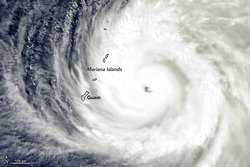 Before reaching the islands, Yutu's sustained winds were reported to be 175 MPH. The storm is now tracking northwest toward the Philippines and Taiwan.
Before reaching the islands, Yutu's sustained winds were reported to be 175 MPH. The storm is now tracking northwest toward the Philippines and Taiwan..jpeg) While Guam is reporting no serious communication issues, public service communication on Saipan is offline. Several stations in Hawaii, including large contest stations, have HF capability to Guam and Saipan, and some have agreed to pass traffic to Guam/Saipan if needed, Corey said.
While Guam is reporting no serious communication issues, public service communication on Saipan is offline. Several stations in Hawaii, including large contest stations, have HF capability to Guam and Saipan, and some have agreed to pass traffic to Guam/Saipan if needed, Corey said..JPG) At this point, VP6D is approaching 30,000 contacts with nearly 10,000 unique call signs. Some 4,000 contacts had been made on FT8 as of October 24, and 141 DXCC entities were in the log. "We know some FT8 Qs are not in the log yet [but we're] working that problem," the update said. The VP6D team has also acknowledged issues with the near-live DXA online log display.
At this point, VP6D is approaching 30,000 contacts with nearly 10,000 unique call signs. Some 4,000 contacts had been made on FT8 as of October 24, and 141 DXCC entities were in the log. "We know some FT8 Qs are not in the log yet [but we're] working that problem," the update said. The VP6D team has also acknowledged issues with the near-live DXA online log display.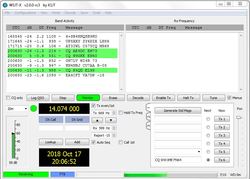 "[O]ne thing is for sure: Downloading the software and trying it out a week before the contest is not a good plan, either for you or for those of us who write and polish the software," Taylor said. "You need practice and experience with the software before the contest." Taylor reminded readers that the original motivation for developing nearly all of the WSJT-X modes was VHF DXing and contesting; however, the software became very popular on HF. A couple of major DXpeditions have included FT8 in their mix of modes, and FT8 lately has been edging into the contesting arena, with its inclusion in the ARRL RTTY Roundup in 2019.
"[O]ne thing is for sure: Downloading the software and trying it out a week before the contest is not a good plan, either for you or for those of us who write and polish the software," Taylor said. "You need practice and experience with the software before the contest." Taylor reminded readers that the original motivation for developing nearly all of the WSJT-X modes was VHF DXing and contesting; however, the software became very popular on HF. A couple of major DXpeditions have included FT8 in their mix of modes, and FT8 lately has been edging into the contesting arena, with its inclusion in the ARRL RTTY Roundup in 2019..jpg)
 Sponsored by
Sponsored by 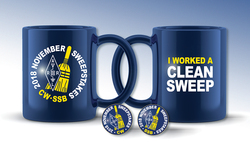 sections worked is a score multiplier. Making a "clean sweep" is the goal of many SS aficionados -- working all 83 of the available US and Canadian multipliers, and qualifying for a clean sweep coffee mug. In the 2017 CW event, only 10 operators managed to work them all. Phone participants had better luck, with 78 clean sweeps. Last year, Puerto Rico (PR) and the US Virgin Islands (VI) were still reeling from devastating hurricanes, making those sections rare.
sections worked is a score multiplier. Making a "clean sweep" is the goal of many SS aficionados -- working all 83 of the available US and Canadian multipliers, and qualifying for a clean sweep coffee mug. In the 2017 CW event, only 10 operators managed to work them all. Phone participants had better luck, with 78 clean sweeps. Last year, Puerto Rico (PR) and the US Virgin Islands (VI) were still reeling from devastating hurricanes, making those sections rare..jpg)
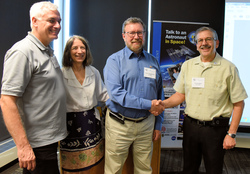
.jpg) "I received the news that I can leave Chad immediately," Opskar
"I received the news that I can leave Chad immediately," Opskar 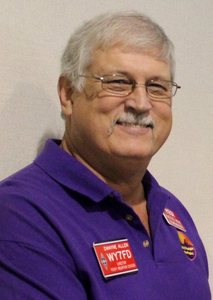 Dwayne Allen, WY7FD, resigned on October 19 as Rocky Mountain Division Director. In a letter to ARRL President Rick Roderick, K5UR, Allen cited time constraints and competing duties with work and family. The Secretary of the Corporation declared the position vacant, and in accordance with Article 7 of the Articles of Association, Vice Director Jeff Ryan, K0RM, has assumed the Director position. President Roderick will appoint a new Vice Director.
Dwayne Allen, WY7FD, resigned on October 19 as Rocky Mountain Division Director. In a letter to ARRL President Rick Roderick, K5UR, Allen cited time constraints and competing duties with work and family. The Secretary of the Corporation declared the position vacant, and in accordance with Article 7 of the Articles of Association, Vice Director Jeff Ryan, K0RM, has assumed the Director position. President Roderick will appoint a new Vice Director..png) Boy Scouts of America Jamboree on the Air (JOTA) Coordinator Jim Wilson, K5ND, is urging JOTA participants to
Boy Scouts of America Jamboree on the Air (JOTA) Coordinator Jim Wilson, K5ND, is urging JOTA participants to  WRTC 2018 QSL cards are on order. World Radiosport Team Championship 2018 (
WRTC 2018 QSL cards are on order. World Radiosport Team Championship 2018 ( Predicted solar flux is 70 on October 25 - 26; 68 on October 27 - November 5; 70 on November 6 - 18; 69 on November 19 - 20; 68 on November 21 - December 2, and 70 on December 3 - 8.
Predicted solar flux is 70 on October 25 - 26; 68 on October 27 - November 5; 70 on November 6 - 18; 69 on November 19 - 20; 68 on November 21 - December 2, and 70 on December 3 - 8.







